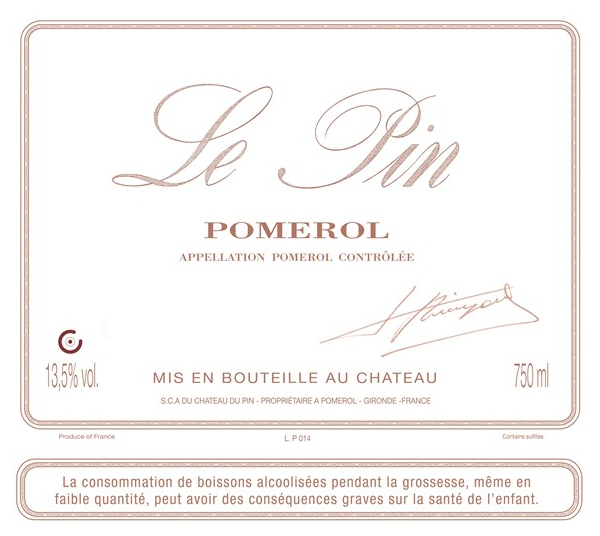Château Le Pin 1990
Chateau Le Pin, or simply Le Pin, is a Bordeaux wine from the appellation Pomerol. The unusually small estate is located on the Right Bank of France's Gironde estuary in the commune of Pomerol near the hamlet of Catusseau, Chateau Le Pin is frequently one of the world's most expensive red wines.
Madame Laubie, whose family had owned Chateau Le Pin since 1924 sold the one hectare vineyard in 1979 to the Belgian Jacques Thienpont for 1 million francs. The vineyards were developed by Jacques Thienpont whose family own the neighbouring Vieux Chateau Certan, and the wine at Chateau Le Pin was produced in tiny quantities from a farmhouse basement. The property was already called Le Pin from a solitary pine tree that grows near the winery. Today the estate comprises 2,7 hectares in one contiguous vineyard surrounding the winery. In 2011 a new winery, designed by the Belgian architectural practice Robbrecht en Daem architecten, was inaugurated using small microcuves and gravity to move Chateau Le Pin wine.
Chateau Le Pin is considered by some a predecessor of the "garage wines", although this idea is rejected by many, including by the proprietors, on the basis of the merits of the terroir, and the absence of extreme measures to compensate for mediocre grapes.
Chateau Le Pin occasionally the most expensive wine in the world, continually receiving high wine ratings from wine critics and produced in extremely small numbers, Chateau Le Pin bottles are a constant presence on the wine auction market.
The winery is currently managed by Jacques Thienpont, and additional tiny plots of land have been acquired. Chateau Le Pin is among the clients of the oenologist Dany Rolland, wife of Michel Rolland.

Vineyard
Surface area: 5 acres
Grape Varieties: 92% Merlot, 8% Cabernet Franc
Average age of vines: 28 years
Density of plantation: 6,000 vines per hectare
Average yields: 34 hectoliters per hectare
Average cases produced: 600 per year
Plateau of maturity: 8 - 25 years
Château Le Pin 1990 Reviews / Tasting Notes
Robert Parker - The Wine Advocate
Point Score: 98
The 1990 Le Pin has more in common with the 1982 than most wines of this vintage. This wine exhibits concentrated fig, blackberry, creme de cassis, kirsch, roasted coffee, herb, and spice box characteristics, and incredible amounts of glycerin as well as velvety tannins. Still tasting like an adolescent, it rocks and rolls across the palate in a glorious manner. Anticipated maturity: now-2025.
Wine Spectator
Point Score: 99
This offers a perfect marriage of lightly mulled raspberry and boysenberry fruit, with delightful allspice, juniper and alder notes that are so fine-grained they have a cashmere feel. Hints of rooibos, bergamot and black tea weave in on the finish, where a light sanguine echo hangs like the tightly pitched buzz of a tuning fork. A pretty incredible display of length, too. Sublime.
Neal Martin - Vinous
Point Score: 94
Tasted at the Pomerol Comparative Exploration tasting in London, the 1990 Le Pin has a mature bouquet with singed leather, clove, smudged black fruit and mint, turning a little feral and animally in the glass. It does not have the sophistication of the 1989 Le Pin tasted alongside and felt unruly in comparison. That theme continues onto the palate is plush tannin, a mixture of black and blue fruit, slightly lower in acidity than the 1989 and yet utterly seductive. There is a giddy plushness to this Pomerol, deep and enveloping, yet with 26 years on the clock, it has lost some of the tension that I found ten or fifteen years ago. It is as if this Le Pin has just decided to let it all hang out in middle age, no longer desires to keep up with the likes of Lafleur or Petrus. Nevertheless, it remains just one gorgeous Pomerol from Jacques Thienpont.